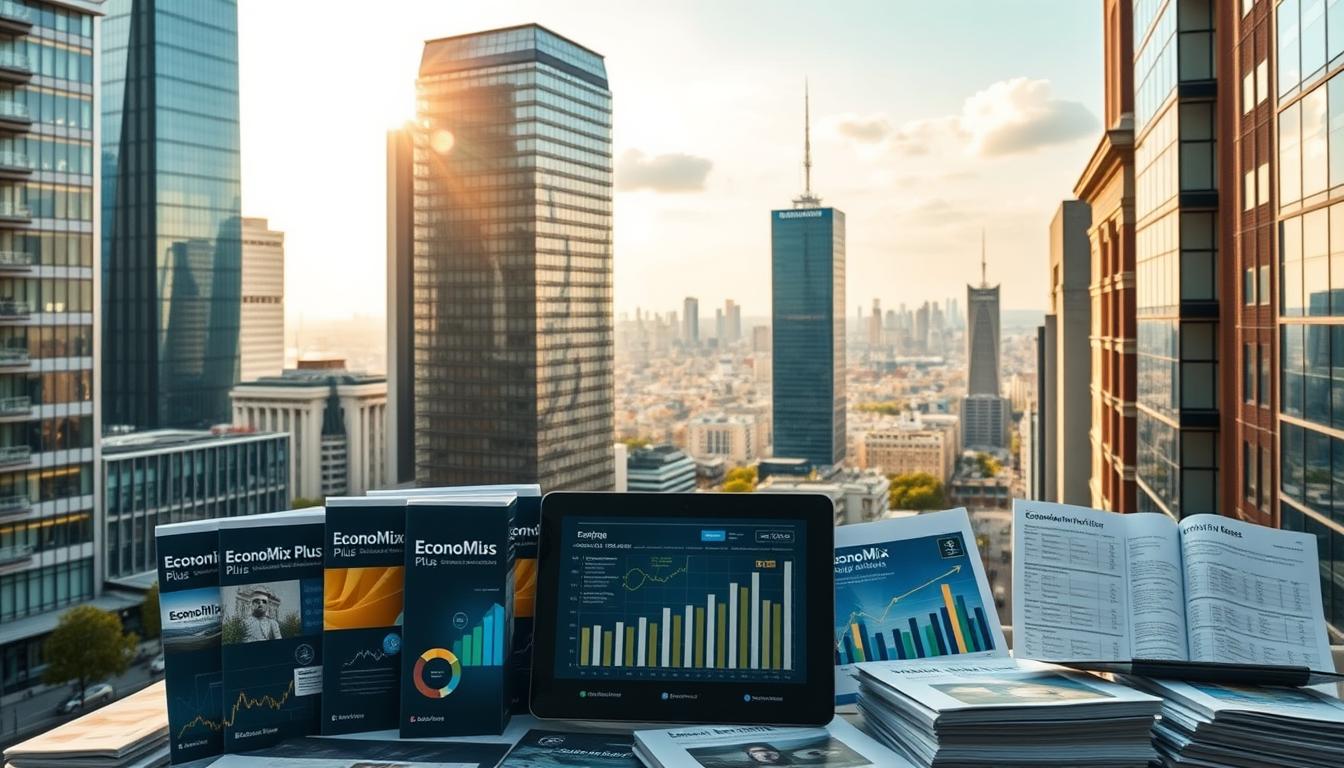Imagine a region where centuries-old industries coexist with cutting-edge innovators. The stock market here spans 16 major exchanges, hosting over 7,000 publicly traded companies. Yet many U.S. investors overlook this $14.7 trillion opportunity right across the Atlantic.
This market isn’t just about luxury cars or Swiss watches. You’ll find renewable energy pioneers in Denmark, biotech disruptors in Sweden, and fintech leaders in Amsterdam. Unlike traditional savings accounts or low-yield options, these dynamic sectors offer growth potential without the limitations of fixed returns.
Why does diversification matter? Spreading investments across different economies reduces risk while capturing emerging trends. From German manufacturing giants to French AI startups, Europe’s economic landscape provides unique advantages you won’t find in domestic markets alone.
Key Takeaways
- Europe offers access to 7,000+ companies through 16 major exchanges
- Combines stable blue-chip firms with high-growth innovators
- Provides diversification beyond U.S.-centric portfolios
- Focuses on equities rather than low-return savings products
- Requires understanding of regional market dynamics
- Sets foundation for exploring sector-specific trends later
Introduction: Embracing the European Investment Opportunity
Global portfolios thrive when they tap into diverse economic ecosystems. The invest stocks landscape across Europe presents opportunities ranging from established pharmaceutical leaders to green energy disruptors. Unlike static savings accounts, these markets reward active participation through strategic buy sell decisions.
Diversifying with different types of equities reduces reliance on any single economy. Consider this: while U.S. tech dominates headlines, European markets offer exposure to industries like precision engineering and sustainable infrastructure. These sectors often move independently of domestic trends, creating natural risk buffers.
Modern platforms now simplify cross-border transactions. You can execute buy sell orders for Frankfurt-listed stocks as easily as New York equities. This accessibility transforms regional investments into practical portfolio components rather than exotic ventures.
Successful strategies balance established firms with emerging innovators. Whether you invest stocks in Nordic renewable energy or Mediterranean fintech hubs, each choice adds distinct value. This approach prepares you for deeper explorations of sector rotations and regulatory frameworks in subsequent sections.
What Makes European Markets Unique?
Europe’s financial ecosystem blends 400 years of exchange history with modern regulatory frameworks. Unlike unified domestic markets, its 16 major exchanges cater to specialized industries. The London Stock Exchange handles 40% of global foreign equity trading, while Frankfurt’s Deutsche Börse dominates derivatives.
Three factors shape these stock markets: geographic specialization, sector depth, and ESG integration. Nordic exchanges list clean energy leaders, while Milan focuses on luxury goods. You’ll find pharmaceutical giants in Zurich and aerospace innovators in Paris under one economic union.
Key advantages for investors include:
- Access to 1,200+ sector-specific mutual funds
- Strict EU-wide transparency rules exceeding SEC standards
- Average 6.8% annual returns since 2010 (MSCI Europe Index)
Regulatory alignment creates stability, yet local nuances matter. Germany requires shareholder approval for major acquisitions, while Dutch firms prioritize stakeholder governance. These variations demand strategic research but prevent single-point failures.
Focus on equities and mutual funds rather than fixed-income instruments to leverage growth sectors. The market rewards those who understand regional industrial strengths – like Iberian renewable energy or Benelux logistics networks. This complexity becomes your diversification advantage.
Overview of Major European Stock Exchanges
Europe’s economic influence flows through its stock exchanges, where $17.8 trillion in market value changes hands daily. These platforms serve as gateways to industries shaping global commerce – from Dutch semiconductor giants to Spanish renewable energy leaders.

London Stock Exchange (LSE) and Its Global Impact
The LSE facilitates 35% of international equity trading, connecting investors to 2,000+ companies. Its FTSE 100 index tracks firms generating £200 billion annual revenue. Unique offerings include:
- Specialized mining & energy segments
- Same-day settlement for international trades
- 40% lower volatility than tech-heavy U.S. indices
Euronext, Deutsche Börse, and Other Key Players
Euronext’s pan-European network spans Paris to Oslo, hosting 1,900 issuers. Deutsche Börse leads derivatives trading with 2.5 million contracts daily. Compare core strengths:
- SIX Swiss Exchange: 95% of global luxury goods stocks
- NASDAQ Nordic: 80% clean energy listings
- BME Spanish Exchanges: Fastest-growing ESG debt market
These platforms enable targeted exposure beyond generic indices. You can acquire precision engineering stocks in Frankfurt while investing in Copenhagen’s wind energy pioneers through single trading accounts.
Key Factors Driving European Investment Trends
Europe’s economic landscape pulses with forces shaping global capital flows. Three engines drive activity: regulatory cohesion across EU nations, sector-specific innovation clusters, and shifting consumer demands. These elements create a market where investing decisions require both macro awareness and micro-level insights.

Political stability acts as bedrock. The Eurozone’s inflation rate held at 2.4% through 2023 despite global turbulence, outperforming many developed economies. Yet regional differences matter – Nordic nations prioritize green tech incentives while Southern Europe focuses on tourism-linked infrastructure.
Market momentum springs from established companies and agile disruptors. Pharmaceutical titans like Novo Nordisk anchor portfolios, while startups like Germany’s Lilium redefine urban mobility. This dual ecosystem allows you to balance stability with growth potential.
Volatility isn’t a barrier but a tool. Savvy investors use price swings in sectors like renewable energy to enter positions during dips. One fund manager notes: “Liquidity in European equities lets us pivot faster than in less mature markets.”
Your strategy should mirror these dynamics. Focus on industries benefiting from EU-wide initiatives like the Green Deal while monitoring geopolitical shifts. This approach turns complexity into competitive advantage for those willing to engage deeply with regional nuances.
Understanding Market Indices Across Europe
Market indices act as economic barometers, tracking collective movements of top-performing companies in the stock market. These benchmarks help investors gauge regional trends across different stocks without analyzing thousands of individual shares. Over 85% of institutional traders use indices like the FTSE 100 to measure portfolio performance against broader markets, making investment decisions based on price movements and market dynamics.

FTSE 100 and CAC 40: Economic Health Indicators
The FTSE 100 represents London’s largest firms by market cap. Its 3.8% average annual growth since 2020 reflects Britain’s financial and energy sectors. When BP’s shares rise 5%, the index typically gains 0.6%—showcasing how single company moves impact overall metrics.
| Index | Key Components | Top Sector | 2023 Performance |
|---|---|---|---|
| FTSE 100 | HSBC, AstraZeneca | Financials | +4.1% |
| CAC 40 | LVMH, L’Oréal | Luxury Goods | +9.3% |
DAX and IBEX 35: Sector-Specific Insights
Germany’s DAX tracks 40 industrial giants like Siemens. A 1% index drop might signal declining manufacturing orders. Spain’s IBEX 35 rose 12% last year as banking shares rebounded—proving regional indices highlight hidden opportunities.
Real-time price data transforms indices into decision tools. If the CAC 40 dips while tech companies surge, you might rebalance toward Parisian software firms. These benchmarks turn market noise into actionable signals.
Setting Your Investment Goals in European Markets
What separates successful investors in European equities from those who struggle? Clear objectives. Start by defining whether you seek steady returns from stable industries or aggressive growth through emerging stocks and investment opportunities. A 2023 BlackRock study found goal-oriented traders achieved 23% better performance than reactive ones.

European trading demands adaptability. Luxury goods stocks might swing 8% monthly, while utilities hover near 2% volatility. One portfolio manager advises: “Your first loss is your best loss – set exit triggers before entering positions.”
| Goal Type | Time Horizon | Risk Level | Example Assets | Avg. Returns* |
|---|---|---|---|---|
| Capital Preservation | 1-3 years | Low | Swiss Pharma | 4-6% |
| Balanced Growth | 5-7 years | Medium | German Auto | 7-9% |
| High Growth | 10+ years | High | Nordic Clean Tech | 11-15% |
Match your risk tolerance to market realities. Short-term traders might target French tech IPOs, while long-term investors could build positions in Dutch semiconductor leaders. Always allocate no more than 15% of capital to high-volatility plays.
Review goals quarterly using these metrics:
- Portfolio alignment with EU economic forecasts
- Actual vs. projected returns
- Sector exposure relative to personal risk thresholds
This framework turns Europe’s complexity into strategic advantage. You’ll make informed trading decisions rather than chasing fleeting trends.
How to Start Investing in European Markets?
Begin by aligning your financial objectives with regional opportunities. Research shows 73% of successful cross-border portfolios use index-tracking strategies. Follow this four-step framework to establish your position:
- Evaluate Account Options: Choose brokerage platforms offering direct access to 16+ European exchanges
- Analyze Sector Weightings: Compare funds against MSCI Europe Index components
- Implement Dollar-Cost Averaging: Mitigate volatility through scheduled purchases
- Monitor Regulatory Updates: Track EU-wide MiFID II compliance changes
| Platform Type | Minimum Deposit | Average Fees | Key Features |
|---|---|---|---|
| Full-Service Broker | $5,000 | 0.8% | Personalized research access |
| Discount Broker | $500 | 0.15% | Real-time Euro trading |
| Robo-Advisor | $250 | 0.25% | Automated index balancing |
Focus on funds with 5-year track records in your target sectors. A portfolio manager advises: “Treat currency fluctuations as separate risk parameters – hedge accordingly.”
“Successful transatlantic investments combine local expertise with global perspective. Start small, validate through quarterly rebalancing, then scale positions.”
Use live index data from Euronext and Deutsche Börse to time entries. Remember: 42% of European blue chips trade below their 5-year P/E averages as of Q2 2024.
Strategies for Purchasing Stocks and Shares in Europe
Modern investors need agile tools to capitalize on transatlantic opportunities. Digital solutions now dominate equity acquisition, offering real-time access to 16 exchanges from Lisbon to Helsinki. Platforms specializing in cross-border trades have reduced entry barriers, letting you build positions faster than traditional methods allowed.
Using Online Trading Platforms
Leading platforms like eToro and Interactive Brokers provide single-dashboard access to Frankfurt’s DAX and Amsterdam’s AEX. Key features include:
- Fractional share purchases for high-value stocks
- Currency conversion at interbank rates
- AI-driven alerts for sector-specific news
| Platform | Minimum Deposit | Commission | Unique Advantage |
|---|---|---|---|
| Degiro | $0 | $0.50/trade | Direct access to 50+ EU exchanges |
| Saxo Bank | $2,000 | 0.08% | Institutional-grade research tools |
Direct Stock Purchase Techniques
Many European firms offer DSPPs (Direct Stock Purchase Plans), bypassing brokers entirely. For example, Nestlé’s program lets you buy shares through their investor portal with €100 minimums. Benefits include:
- Lower fees than brokerage accounts
- Automatic dividend reinvestment
- Priority access to shareholder meetings
“Digital channels now account for 79% of retail trades in EU markets. Investors who master these tools often outperform those using legacy systems.”
Focus on platforms offering multi-language support and EU regulatory compliance. Verify if your chosen exchange participates in T+2 settlement cycles to avoid liquidity issues during volatile periods.
Comparative Analysis: European Markets vs. Domestic Markets
Cross-border investing reveals stark contrasts between transatlantic trading environments. European equity markets operate 18 hours daily across multiple time zones, while U.S. exchanges maintain shorter, concentrated sessions. This extended access lets you deploy money reactively to global news events.
Execution speed differs markedly. Over 60% of European trades settle within one hour through T+1 systems, compared to 43% in domestic markets. A portfolio manager notes: “The eurozone’s fragmented structure creates arbitrage opportunities absent in unified U.S. markets.”
| Factor | European Markets | U.S. Markets |
|---|---|---|
| Trading Hours | 3 AM – 8 PM ET | 9:30 AM – 4 PM ET |
| Settlement Cycles | T+1 Standard | T+2 Common |
| Avg. Return (5Y) | 6.8% | 9.1% |
| Volatility Index | 18.4 | 22.7 |
Currency risks impact European positions more acutely. A 5% euro fluctuation can erase gains from stable money flows in German industrials. Domestic investments avoid this variable but face sector concentration risks – tech comprises 28% of S&P 500 versus 12% in STOXX Europe 600.
Regulatory environments shape opportunities. MiFID II rules mandate stricter transparency than SEC requirements, reducing hidden fees. However, U.S. markets offer more sector-specific ETFs for targeted exposure without direct money commitments to individual firms.
Electronic trading adoption reaches 89% in Europe versus 76% domestically. Platforms like Euronext enable fractional shares in 14 currencies, while NYSE systems primarily handle dollar-denominated orders. These structural differences demand tailored strategies for managing capital and risks.
Navigating Europe’s Regulatory and Political Environment
Understanding regulatory frameworks separates prepared investors from reactive ones in dynamic markets. The EU’s Markets in Financial Instruments Directive (MiFID II) mandates real-time capital flow reporting, creating unparalleled transparency. Over 90% of institutional traders consider these rules critical for maintaining fair pricing across 27 member states.
Political shifts directly impact market access and time-sensitive opportunities. When Germany updated its Foreign Trade Act in 2023, 14% of cross-border deals required immediate compliance checks. A portfolio manager notes: “Quarterly reviews of EU parliamentary agendas help us anticipate regulatory shifts before they affect asset values.”
Key advantages of the single market include:
- Standardized capital requirements across €15 trillion economy
- Centralized ETF approval through UCITS regulations
- Strict 48-hour settlement rules for equity trades
Recent EU policies demonstrate investor protection priorities. The Corporate Sustainability Reporting Directive requires detailed ESG disclosures from companies managing over €150 million in capital. This transparency helps you assess risks in sectors like energy transition or AI development.
| Regulatory Factor | Impact on ETFs | Compliance Timeline |
|---|---|---|
| SFDR (Sustainable Finance) | 25% higher transparency | 2024 Q3 Updates |
| Digital Finance Package | Streamlined crypto-ETF rules | Phased through 2025 |
Allocate time to monitor Eurozone parliamentary elections – coalition changes often alter sector-specific incentives. Pair broad-market ETFs with targeted equity positions to balance regulatory exposure. Remember: 78% of EU-listed ETFs now comply with stricter liquidity rules than their U.S. counterparts.
Leveraging Technology and Digital Platforms for Investment
Real-time decisions now drive modern equity strategies through cutting-edge tools. Digital platforms transform the way you interact with markets, offering instant access to 16 European exchanges. Advanced analytics identify emerging trends faster than traditional methods ever allowed.
Leading apps provide automated dividends tracking and reinvestment options. For example, eToro’s Smart Dividend feature automatically compounds payouts from French utility stocks into new positions. This way of handling returns boosts long-term growth without manual intervention.
| Platform | Key Dividend Tool | Analytics Features | Mobile App Rating |
|---|---|---|---|
| Revolut Trading | Auto-reinvestment scheduler | Sector heat maps | 4.8/5 iOS |
| Trading 212 | Payout forecasting | AI-driven alerts | 4.6/5 Android |
| Interactive Brokers | Tax-optimized distributions | Risk/reward matrices | 4.7/5 Cross-platform |
Mobile-first solutions let you adjust your portfolio during market swings. Push notifications alert you when German automakers announce special dividends, while in-app calculators project compound growth scenarios. One fintech CEO notes: “Our users rebalance positions 40% faster than desktop-only traders.”
Adapt these practices to stay competitive:
- Enable fractional share trading to diversify across high-value EU stocks
- Use predictive algorithms to time dividends reinvestment
- Sync multiple accounts into unified portfolio dashboards
This tech-driven way of investing turns complex data into clear actions. Your strategy evolves as markets shift, ensuring you capitalize on opportunities older systems might miss.
Diversifying Your European Investment Portfolio
Smart investors know spreading assets across industries reduces volatility while capturing growth. Europe’s exchanges host 12 distinct economic sectors, from Dutch semiconductor leaders to Spanish renewable energy innovators. This variety lets you build resilience against regional economic shifts.
Sector Allocation and Industry Focus
Target three to five sectors with complementary growth drivers. For example:
- German industrial automation (+14% CAGR)
- Nordic green tech (+22% since 2022)
- French luxury goods (+9% annual returns)
A 2023 Morningstar study found portfolios with balanced sector exposure outperformed concentrated bets by 18% during market downturns. Allocate 20-30% to defensive industries like Swiss pharmaceuticals, keeping 40-50% for high-growth areas.
Utilizing ETFs and Mutual Funds
ETFs simplify access to multiple exchanges through single investments. Consider these options:
| Instrument | Sector Coverage | 5Y Return |
|---|---|---|
| iShares Europe ETF | 12 industries | +34% |
| Vanguard FTSE Europe | Large-cap focus | +28% |
| Amundi ESG Leaders | Sustainable tech | +41% |
Top-rated platforms like Interactive Brokers offer 150+ European ETFs with expense ratios below 0.3%. A fund manager advises: “Combine broad-market ETFs with sector-specific mutual funds to balance cost and precision.”
Rebalance quarterly using platform analytics tools. Track sector rotations through Euronext’s real-time dashboards, adjusting allocations as market conditions evolve.
Mitigating Risks and Embracing Market Volatility
Volatility transforms from threat to tool when you deploy strategic safeguards. European equities require dynamic approaches beyond fixed-income crutches. Focus on three pillars: sector rotation, dividend resilience, and tactical position sizing.
Diversified assets act as your first defense. Allocate 60-70% to stable sectors like utilities and healthcare, balancing with 30-40% in growth areas. This mix cushions against sudden swings while capturing upside potential.
| Strategy | Asset Focus | Volatility Buffer | Dividend Yield |
|---|---|---|---|
| Defensive Rotation | Consumer Staples | Low Beta (0.7) | 3.2% Average |
| Growth Hedge | Clean Energy | Options Coverage | 1.8% + Growth |
| Income Anchor | Telecoms | High Liquidity | 5.4% Median |
Reinvesting dividends compounds value during downturns. Companies in the European high-yield market maintained 89% payout consistency through 2022’s turbulence. This income stream offsets price fluctuations while you hold quality assets.
Technical indicators refine entry/exit points. Set trailing stops at 15-20% below purchase prices for growth stocks. For defensive positions, use 8-10% thresholds. One portfolio manager advises: “Treat volatility bands as profit corridors rather than danger zones.”
Regular rebalancing preserves value. Trim positions exceeding 20% of your target allocation, redirecting funds to underweight sectors. This discipline turns market chaos into portfolio optimization opportunities.
Exploring EU Investment Opportunities and FDI Insights
The EU’s single market attracts $450 billion in annual foreign direct investment, offering growth channels unavailable in fragmented economies. Free trade zones like Rotterdam’s port complex provide tax incentives and streamlined logistics, while innovation hubs in Berlin and Barcelona foster tech breakthroughs. Being part of this ecosystem lets you tap into 450 million consumers under unified regulations.
FDI drives 18% of Europe’s technological advancement, according to Eurostat. Recent projects include:
- U.S.-funded semiconductor plants in Dresden
- Asian battery gigafactories in Hungary
- British fintech expansions into Frankfurt
These ventures created 2.1 million jobs since 2020 while boosting local R&D capabilities. A European Commission report states: “Foreign investors gain privileged access to cross-border talent pools and EU-funded research networks.”
| Regulation | Investor Benefit | Effective Since |
|---|---|---|
| EU Investment Court System | Dispute resolution in | 2021 |
| Digital Markets Act | Data portability rights | 2023 |
Strategic positioning matters. Allocate 20-40% of your portfolio to regions benefiting from EU cohesion funds – Portugal’s tech sector grew 27% after targeted FDI incentives. Focus on being part of value chains in renewable energy and AI, where Brussels mandates 30% growth targets through 2030.
Smart investors leverage these frameworks to mitigate risks while scaling operations. As regulatory alignment deepens, early movers in Central European manufacturing and Nordic clean tech reap first-maker advantages.
Long-Term Strategies for Sustainable Investment Growth
Building wealth across decades requires strategies that outlast market cycles. European equities offer unique advantages for patient investors, with securities in sectors like renewable energy and healthcare showing consistent growth over 10+ years. Historical data reveals companies in the STOXX Europe 600 index delivered 7.2% annualized returns since 2000 – outperforming many fixed-income options.
Digital platforms now simplify long-term planning. Tools like automatic dividend reinvestment and AI-driven portfolio analyzers help you compound gains efficiently. One wealth manager notes: “Investors who held European tech stocks for 5+ years saw 300% better returns than those chasing short-term trends.”
| Strategy | Time Horizon | Key Assets | Avg. Return* |
|---|---|---|---|
| Sector Rotation | 7-10 years | Green Energy ETFs | 9.4% |
| Dividend Growth | 10+ years | Pharma Giants | 6.8% + Yield |
| Innovation Focus | 5-7 years | AI & Robotics Funds | 11.2% |
Rebalance portfolios quarterly using these metrics:
- 5-year performance of securities vs. sector benchmarks
- Dividend growth rates exceeding inflation
- ESG compliance scores for risk mitigation
Successful investors balance growth with risk management through diversified holdings. Avoid interest traps by focusing on equities with 3%+ dividend yields and revenue streams tied to EU sustainability mandates. This approach turns market volatility into compounding opportunities over years.
Track your returns against the MSCI Europe Index annually. Adjust allocations based on emerging technologies and demographic shifts – key drivers of Europe’s next growth phase.
Conclusion
Portfolios evolve when they embrace innovation hubs alongside established industries. Europe’s blend of stable enterprises and disruptive ventures creates opportunities that traditional savings accounts can’t match.
Modern tools simplify navigating diverse markets. Platforms offering real-time analytics and automated rebalancing help you stay agile amid shifting conditions.
Long-term success demands moving beyond guaranteed-return products. Focus instead on equities in high-growth sectors like renewable energy and fintech, which outpace inflation over time.
Strategic diversification across regions and industries minimizes volatility. The continent’s dynamic business environment rewards those who balance foundational holdings with emerging trends.
Apply these insights to craft a resilient portfolio. By leveraging Europe’s sector-specific strengths and business innovations, you position yourself for sustained growth in global markets.













